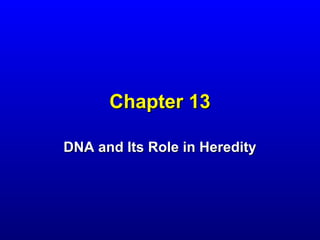
Chapter 13
- 1. Chapter 13 DNA and Its Role in Heredity
- 2. Review of DNA Structure Four key features of DNA structure: • It is a double-stranded helix of uniform diameter • It is right-handed • It is antiparallel • Outer edges of nitrogenous bases are exposed in the major and minor grooves
- 3. Review of DNA Structure Complementary base pairing: • Adenine (A) pairs with thymine (T) by two hydrogen bonds • Cytosine (C) pairs with guanine (G) by three hydrogen bonds • Every base pair consists of one purine and one pyrimidine
- 4. Review of DNA Structure Two Copies of the same sequence, just reverse compliments
- 5. Four Important Functions of DNA 1) Stores genetic information 2) Is susceptible to mutation 3) Is precisely replicated in cell division 4) Is expressed as the phenotype
- 6. DNA Replication Three possible replication patterns: • Semiconservative: Parent serves as a template and new molecules have one old and one new strand • Conservative: Original helix only serves as a template • Dispersive: Parent fragments serve as templates, assembling old and new parts into molecules
- 7. Semi-Conservative Replication Two steps in DNA replication: • The double helix is unwound, making two template strands • New nucleotides are added to the new strand at the 3′ end and joined by phosphodiester linkages. Sequence is determined by complementary base pairing
- 8. Strands Grow from the 3’ End
- 9. How does Replication Initiate A large protein complex called the “replication complex” interacts with the template strands. All chromosomes have a region called origin of replication (ori). Proteins in the replication complex bind to a DNA sequence in ori.
- 10. Main Components in DNA Replication Primase synthesizes RNA primers to start replication DNA polymerase (I and III) adds nucleotides to the 3′ end. DNA helicase uses energy from ATP hydrolysis to unwind the DNA. Single-strand binding proteins keep the strands from getting back together. DNA ligase “glues” together any gaps in the newly synthesized sequence
- 11. So how does it work? Helicase will unwind the DNA Strand SS-Binding Proteins keep the strands apart Primase hops on and lays down a 10-20bp RNA primer DNA polymerase III recognizes the primers and continues to extend the growing strand by reading the complimentary base pairs DNA polymerase I hopes on and replaces RNA primer with DNA and proofreads the new sequence DNA Ligase then glues together any gaps
- 12. DNA Polymerase • Proof Reading Ability • Can NOT start without a primer or existing template sequence
- 13. Not all DNA Strands are Equal • Leading Strand “Easy Replication” • Lagging Strand is slower and more difficult • Replication Fork
- 14. Leading Strand • Primer is created on the 3’ end of the existing sequence • Replication occurs following the Replication fork until it falls off the other end
- 15. Lagging Strand • Primer is created near the replication fork • The strand is then replicated moving away from the Replication fork • Forms Okazaki Fragments
- 16. After Replication… • DNA pol I replaces all RNA primers with DNA • DNA ligase glues all Okazaki Fragments together • DNA pol can check for errors in sequencing (proofreading)
- 17. PCR Copies of DNA sequences can be made by the polymerase chain reaction (PCR) technique. PCR is a cyclical process: • DNA fragments are denatured by heating • Primers, plus dNTPs and DNA polymerase are added • New DNA strands are synthesized
- 18. PCR
- 19. PCR PCR results in many copies of the DNA fragment—referred to as amplifying the sequence. The base sequence at the 3′ end of the DNA fragment must be known. Complementary primers, about 15–30 bases long, are made in the laboratory.
- 20. PCR An initial problem with PCR was its temperature requirements. The heat needed to denature the DNA destroyed most DNA polymerases. A DNA polymerase that does not denature at high temperatures (90 °C) was taken from a hot springs bacterium, Thermus aquaticus.
- 21. Steps in a typical PCR Cycle 1) Denature 2) Annealing of the Primers 3) Elongation of new sequence DNA Pol Leads to exponential amplification of your target…
